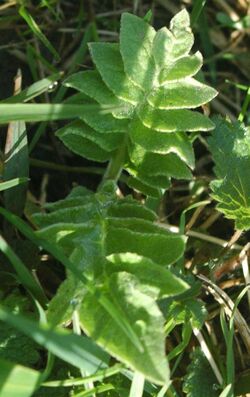Biology:Rhaponticum carthamoides
| Maral root | |
|---|---|

| |
| Scientific classification | |
| Kingdom: | Plantae |
| Clade: | Tracheophytes |
| Clade: | Angiosperms |
| Clade: | Eudicots |
| Clade: | Asterids |
| Order: | Asterales |
| Family: | Asteraceae |
| Genus: | Rhaponticum |
| Species: | R. carthamoides
|
| Binomial name | |
| Rhaponticum carthamoides | |
| Synonyms[1] | |
|
List
| |
Rhaponticum carthamoides, synonym Leuzea carthamoides, is a species of herbaceous perennial plant in the family Asteraceae.[1] It is known as maral root or rhaponticum.[2] It inhabits the sub-alpine zone (4,500–6,000 ft (1,400–1,800 m) above sea level) as well as alpine meadows. It can be found growing wild in Southern Siberia, Kazakhstan, the Altay region, and Western Sayan Mountains. Maral root is widely cultivated throughout Russia and Eastern Europe.[citation needed] This plant derives its traditional name maral root (maralu) from the maral deer that fed on it.[citation needed]
R. carthamoides is high in 20-hydroxyecdysone, one of the most common molting hormones in insects, crabs, and some worms and can disrupt their molting and reproduction.[3]
References
- ↑ 1.0 1.1 1.2 "Rhaponticum carthamoides (Willd.) Iljin.". Plants of the World Online. Royal Botanic Gardens, Kew. http://www.plantsoftheworldonline.org/taxon/urn:lsid:ipni.org:names:241391-1.
- ↑ SysTax - detailed information on Rhaponticum carthamoides (Willd.) Iljin
- ↑ Głazowska, Joanna; Kamiński, Marcin M.; Kamiński, Marian (December 2018). "Chromatographic separation, determination and identification of ecdysteroids: Focus on Maral root (Rhaponticum carthamoides, Leuzea carthamoides)". Journal of Separation Science 41 (23): 4304–4314. doi:10.1002/jssc.201800506. ISSN 1615-9314. PMID 30303602. https://pubmed.ncbi.nlm.nih.gov/30303602.
Wikidata ☰ {{{from}}} entry
 |


